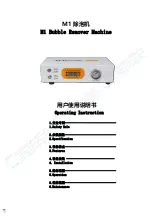
21
Troubleshooting
No relays heard when changing bands:
U1 on the Filter board may have a bent pin, be installed
backwards, or not be programmed. Ceramic resonator Z1 may be damaged or not soldered properly. Also
try swapping in a different band module (if available) to verify that the K1 itself is working.
Difficulties with receiver alignment:
1.
If you can't find a peak at all, and you're using an antenna as the signal source, try using a signal
generator or ham-band transmitter instead; this provides much more signal to work with.
2.
If you can't find a peak at all, and you're already using a signal generator or transmitter, there's
probably an open or short somewhere in the receive path, or a missing signal source (e.g., the premix
crystal oscillator). Make sure the jumper from J2-2 to J2-10 is installed on the Filter board. Try signal
tracing on each affected band, as described in Appendix E of the owner's manual. You can also do
simple noise-injection signal tracing: touch a long antenna wire along various points in the receiver,
looking for a place where touching the antenna produces no increase in audio output.
3.
If just one of the trimmer capacitors seems to have no effect at all, it is probably due to a poorly-tinned
toroid lead on the associated transformer (T1-T4). Also check the winding sense of T3 and T4, as well
as the values of all fixed capacitors in the two filters, i.e. C9-C14 and CJ-CP.
Difficulties with transmitter alignment (receiver is working):
1.
If you see
no
output (or
0 . 1
watt indicated) on
all
bands, first make sure R36 on the RF board is
soldered at both ends. Next, you'll need to do signal tracing (Appendix E of the owners manual).
2.
If power output is 10-20% low on all bands, the supply voltage may be low. Max output should be
typically 5 watts at 12 V and somewhat higher at 14 volts. You could lose a significant amount of
voltage between the supply and the K1 if the power leads are too small; use 20 AWG wire or larger.
Verify power with a known calibrated wattmeter if possible. Check the values of R34, R36, and R37
on the RF board. As a last resort, change R11 on the RF board to 68 ohms to increase drive.
3.
If power output is low only on 40 meters, you may have the wrong number of turns on T3 and/or T4.
In this case, trimmers CG and CH may be at their maximum or minimum settings. (You can tell by
rotating the trimmers to see if you get only one peak in a full turn of the trimmer; normally there will
be peaks in two places in each trimmers' rotation). Also check the values of CL and CM.
4.
If power output is low on
either
30 or 40 meters, but not both, check turns counts on L4, L5, and L6.
You may be able to squeeze or spread the turns of L5 to obtain a compromise between 30 and 40 m.
5.
If power output is low on two bands, there are several possibilities: (1) Swapped or bad crystals at X1-
X4; (2) incorrect number of turns on one or more inductors (re-count all of them); (3) incorrect
capacitor value; (4) trimmers not correctly peaked; (5) poorly-soldered or tinned toroid leads.
General troubleshooting procedure:
(1) make sure the microcontroller is not plugged in backwards and
that it has no bent pins; (2) inspect the board closely for missing components, cold or missing solder joints,
poorly-prepared toroid leads, and solder bridges; (3) make the DC voltage measurements listed below; (4)
refer to the Troubleshooting charts in the K1 owner's manual (Appendix E).
DC Voltages
All voltages on U1 are 0.0 V during normal operation (with AGC ON), except the following:
pin 3, 0.8 V; pins 4 and 14, 6 V; pin 13, 5.5 V; pins 15 and 16, between 0 and 1 V, varying with meter type.




































